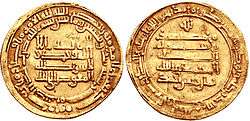Al-Mufawwad
Ja'far ibn al-Mu'tamid, better known by his regnal name of al-Mufawwad ila-llah (Arabic: المفوض إلى الله, "Agent of God"), was a son of the Abbasid caliph al-Mu'tamid and heir-apparent of the Caliphate from 875 until his sidelining by his cousin al-Mu'tadid in 891.
Life

Ja'far ibn al-Mu'tamid is first mentioned on al-Tabari's history in 872.[1] On 20 July 875, al-Mu'tamid formally arranged for the governance of the state and his succession: Ja'far, given the honorific name al-Mufawwad ila-llah, was named heir-apparent and assigned the western half of the Caliphate, while al-Mu'tamid's brother, Abu Ahmad, known as al-Muwaffaq, received the eastern provinces and was named second heir, except for the event that the Caliph died while al-Mufawwad was still a minor. Al-Mufawwad was thus responsible for Ifriqiya, Egypt, Syria, the Jazira and Mosul, Armenia, Mihrajanqadhaq and Hulwan, with Musa ibn Bugha as his deputy.[2][3] Nevertheless, it was al-Muwaffaq who held the actual power in the state, and this division of authority seems to have been mostly on paper; according to Hugh N. Kennedy, "it does not seem that al-Mufawwad exercised any real authority".[3]

When al-Mu'tamid left Samarra in March 876 to lead the army south to confront the Saffarid army in what would be the Battle of Dayr al-'Aqul, al-Mufawwad was left behind to supervise the capital, with the aid of Muhammad al-Muwallad.[4] In 882/3, when al-Mufawwaq and the powerful autonomous governor of Egypt, Ibn Tulun, fell out and open conflict broke out among them, al-Muwaffad was obliged to publicly curse and deprive his nominal subordinate Ibn Tulun of his offices, which went to the governor of Mosul, Ishaq ibn Kundaj.[3][5] In the event, however, Ibn Tulun prevailed over the Abbasid attacks and remained in charge of Egypt, as did his son Khumarawayh after him.[6]
In April 891, while al-Muwaffaq lay dying, an attempt was made to prevent the succession to the regency of his son, Abu'l-Abbas. Al-Muwaffaq had imprisoned his son for an unknown reason, and the governor of Baghdad tried to ensure that he would not be released, and secretly brought both the Caliph and al-Mufawwad into the city to capitalize on al-Muwaffaq's imminent death. The attempt failed due to the support Abu'l-Abbas enjoyed both among the populace and the army: Abu'l-Abbas was released by the troops, the governor's house was ransacked by the mob, and on 4 June, two days after al-Mufawwaq's death, the oath of allegiance was renewed, including Abu'l-Abbas, now under the title al-Mu'tadid bi-llah, as second heir after al-Mufawwad.[7][3] Finally, on 30 April 892, al-Muwaffad was removed from the succession altogether,[8] and when al-Mu'tamid died in October, he was succeeded by al-Mu'tadid.[3]
References
- ↑ Waines 1992, p. 148.
- ↑ Waines 1992, pp. 166–167.
- 1 2 3 4 5 Kennedy 1993, pp. 765–766.
- ↑ Waines 1992, pp. 169ff..
- ↑ Fields 1987, pp. 97–98.
- ↑ Bonner 2010, pp. 322, 323, 335.
- ↑ Fields 1987, p. 176.
- ↑ Fields 1987, pp. 166–169.
Sources
- Bonner, Michael (2010). "The waning of empire, 861–945". In Robinson, Charles F. The New Cambridge History of Islam, Volume I: The Formation of the Islamic World, Sixth to Eleventh Centuries. Cambridge: Cambridge University Press. pp. 305–359. ISBN 978-0-521-83823-8.
- Fields, Philip M., ed. (1987). The History of al-Ṭabarī, Volume XXXVII: The ʿAbbāsid Recovery. The War Against the Zanj Ends, A.D. 879–893/A.H. 266–279. Albany, New York: State University of New York Press. ISBN 0-88706-053-6.
- Kennedy, Hugh N. (1993). "al-Muʿtamid ʿAlā 'llāh". The Encyclopedia of Islam, New Edition, Volume VII: Mif–Naz. Leiden and New York: BRILL. pp. 765–766. ISBN 90-04-09419-9.
- Waines, David, ed. (1992). The History of al-Ṭabarī, Volume XXXVI: The Revolt of the Zanj, A.D. 869–879/A.H. 255–265. Albany, New York: State University of New York Press. ISBN 0-7914-0764-0.